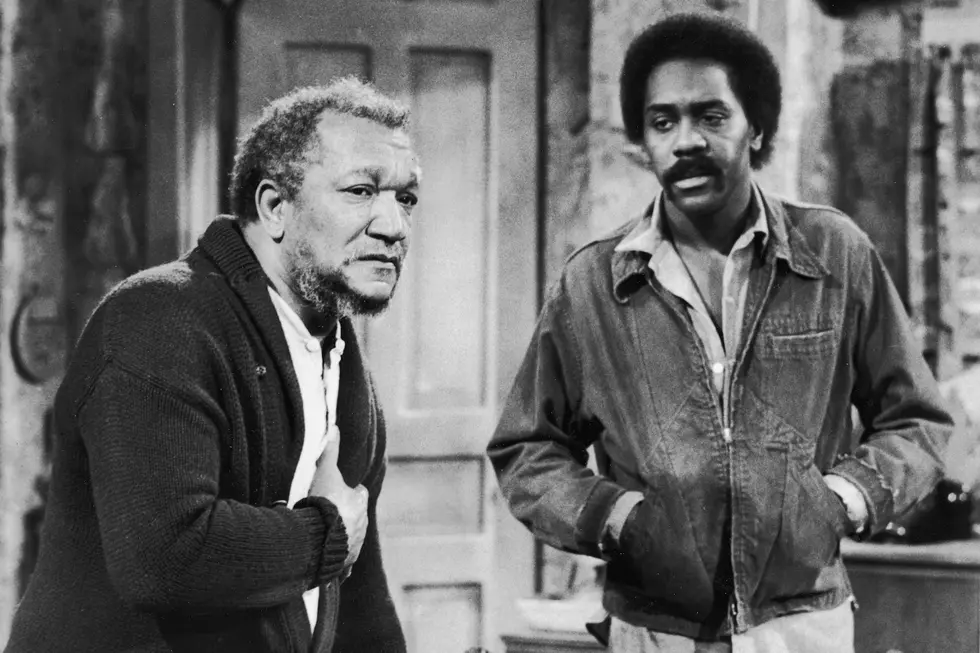
50 Years Ago: ‘Sanford and Son’ Makes Its Groundbreaking Debut
When Sanford and Son premiered on NBC on Jan. 14, 1972, few shows on U.S. television had ever featured Black characters.
On June 14, 1939, actress and singer Ethel Waters headlined a variety program called The Ethel Waters Show and may have been the first Black American to appear on television. In 1956, Nat King Cole hosted a short-lived but nationally televised variety show. And in the '60s both Cicely Tyson and Bill Cosby starred in hour-long dramas, working alongside white co-stars.
But there had been virtually no comedic television centered on Black characters since The Amos and Andy Show in the early '50s, which was based on a radio program in which white performers had done racist impersonations of Black characters and was roundly criticized for its derogating presentations of Black life.
Watch 'Sanford and Son' Intro
The lack of Black shows didn't dissuade famed TV producers Norman Lear and Bud Yorkin, who were already challenging U.S. viewers with their notoriously confrontational series All in the Family. The pair decided to adapt a British sitcom called Steptoe and Son – the same approach they had taken with All in the Family, which was based on a British show called 'Till Death Us Do Part – and to set it in the Watts neighborhood of Los Angeles. It was a daring move, typical of Lear and Yorkin, because to national audiences Watts was then best known as the location of the so-called "Watts Rebellion" of 1965 in which the arrest of a Black motorist by white cops kicked off a series of destructive protests.
Lear and Yorkin's provocations didn't stop there, however. In the main comedic role of their new show, they cast comedian Redd Foxx, whom The New York Times called "the dean of X-rated comedians" and who had recorded more than 50 "party records" –essentially stand-up comedy records – during the '50s and '60s. Lear and Yorkin took Foxx's last name (he was born John Sanford) for the name of the show and named his character Fred Sanford after his older brother.
Sanford and Son centered on Fred's junk shop at 9114 South Central Ave. in Watts, where he lived with his son Lamont (Demond Wilson). The relationship between the two closely mirrored that of Archie Bunker and his son-in-law, Mike, on All in the Family: Fred was cantankerous, annoyed by almost everyone he met and cheap. Lamont was open-minded, gentle and a genuinely good person.
A good deal of the humor in the show came from the clash between these two personalities and from the different ways they dealt with the other recurring characters, from deeply religious Aunt Esther (LaWanda Page) – who was Fred's deceased wife Elizabeth's sister – to Fred's best friend Grady Wilson (Whitman Mayo) and Lamont's best friend Rollo Larson (Nathaniel Taylor). Fred insulted them and was suspicious of nearly everything they did (his character was nearly as acerbic as Foxx's stand-up comedy), while Lamont took them at face value and wanted to see past the issues – particularly racial and cultural issues – that Fred was always highlighting.
Watch 'Sanford and Son' Scenes
This foregrounding of race was radical for network television at the time, and Fred wasn't always portrayed in a positive light. He was full of slurs about other races, including their Puerto Rican neighbor Julio Fuentes (Gregory Sierra) and Lamont's Japanese-American friend Ah Chew (Pat Morita); these aspersions were always balanced by intelligent and humorous protests from Lamont. But the show also refused to steer away from the issues facing Black Americans at the time, such as a famous episode when Fred defended Lamont in traffic court, asking the cop, "What have you got against Black drivers?"
Beyond this treatment of race in the show, there were also the in-front-of and behind-the-camera barriers the program broke. It was the first network comedy after The Amos and Andy Show to feature a predominantly Black cast; its theme music was also composed by a Black artist, Quincy Jones. After Foxx and others complained about diversity in other areas of the show's production during the first season, changes were made there as well. Richard Pryor and Paul Mooney were hired to help write, and groundbreaking Black director Stan Lathan was brought in to direct, getting his start in Hollywood.
Watch 'Sanford and Son' Scene
The biggest myth the show helped destroy was that audiences wouldn't respond to shows featuring minority characters. Sanford and Son averaged 16 million viewers per episode during its first season and was in the Top 10 television shows in the U.S. every year of its six-year run. It was so successful that before it ended in 1977, the program had inspired at least three knockoff shows – Good Times (1974), The Jeffersons (1975) and What's Happening (1976) – and changed the way U.S. viewers thought about television.
But the most lasting quality of Sanford and Son? It managed to be both funny and touching in a way few shows could.
Watch 'Sanford and Son' Scene
Foxx and Wilson were both terrifically talented comedic actors who shared wonderful on-screen chemistry. In a 2001 biography of Foxx, TV editor Michael Starr quoted Yorkin as remembering the first time the two leads rehearsed: "Redd and Demond walked in front of the cameras and did their scene together. It had been only four days since they’d met for the first time at Redd’s house in Las Vegas. The All in the Family cast fell on the floor. … I have never heard guys laughing like that. It went on and on."
For all the groundbreaking elements of Sanford and Son, it was this humane comedy that probably had the biggest impact.
28 Classic Films That Were Turned Into (Mostly Failed) TV Shows
More From










